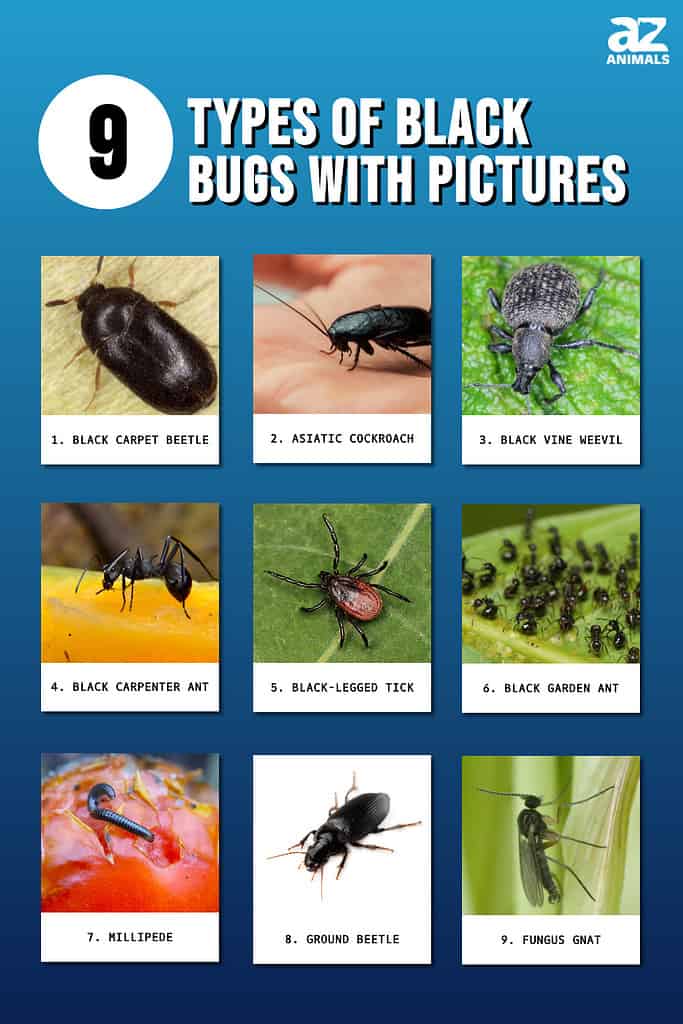
Are you seeing black bugs in your home or around your property? Do you need help identifying a pest so you can rid your dwelling of a nuisance? There are thousands of black bugs just in the United States, so identifying the right species can be challenging. Check out these common types of black bugs and discover how to identify them and what problems they can cause.
1. Black Carpet Beetle
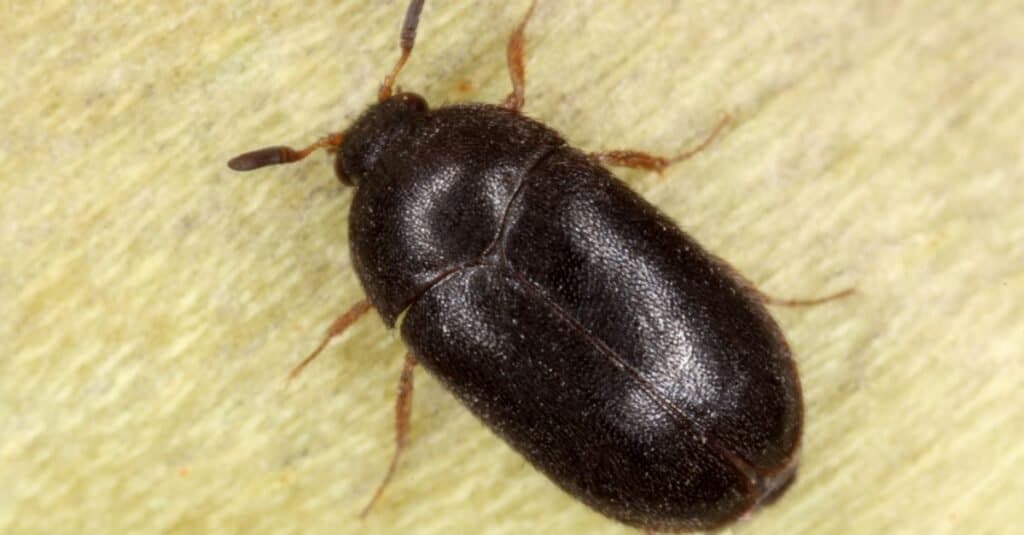
One of the most common big black beetles found in the yard is the black carpet beetle. But they can find their way inside your home.
©Tomasz Klejdysz/Shutterstock.com
Description: Black carpet beetles are oval-shaped and dark brown or black. They measure between 0.12 and 0.20 inches long, and their larvae are a reddish-brown color, featuring bristles along their bodies.
Location/Habitat: You can find these types of black bugs throughout the United States, Canada, and Mexico. They primarily live outside on plants like crape myrtles. You may also find them in rodent nests or near doors and windows.
Diet: Pollen and nectar are their preferred food sources. But they will eat wool, fur, and many other plant or animal-based products.
Problems: The carpet beetle can find their way inside homes, where they are destructive to household items and can cause skin problems in humans.
2. Asiatic Cockroach
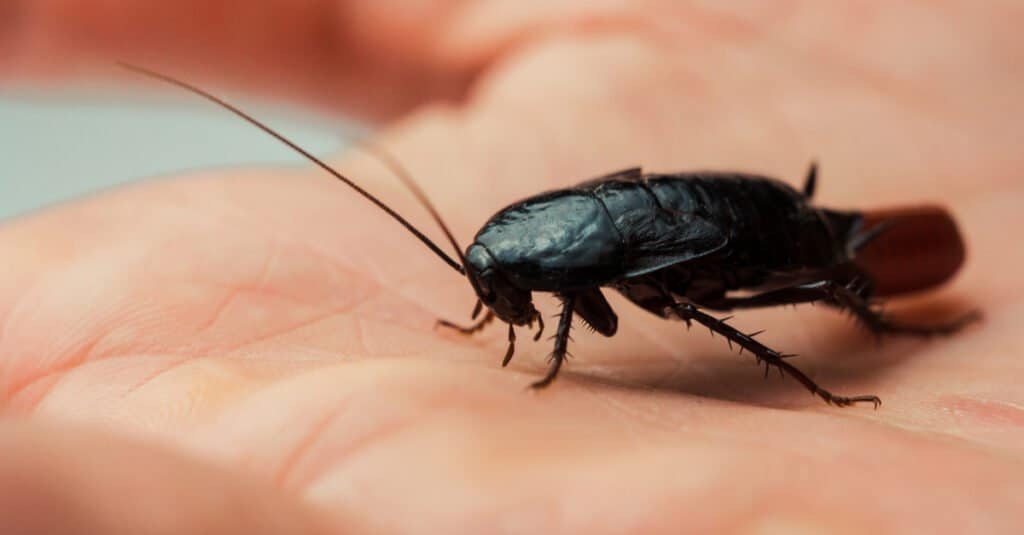
Waterbugs, or Asiatic cockroaches, are a common pest inside homes across the world. They transfer bacteria by crawling across food and surfaces.
©Yuliia Hurzhos/Shutterstock.com
Description: The Asiatic cockroach, also known as the waterbug, can reach over an inch in length. They are dark brown or black and feature a glossy shine. Both sexes have wings but are flightless.
Location/Habitat: These bugs are originally from Southeast Asia but they have spread worldwide. They were first documented in the United States in the 1980s and are now a common household pest.
Diet: Cockroaches eat pretty much anything and seem especially drawn to the trash and decaying organic matter. They are also attracted to sugar, oil, and meat.
Problems: Asiatic cockroaches infest homes, where they transfer bacteria by crawling across food, counters, dishes, and silverware. They can also cause breathing problems from their saliva, feces, and shedding body parts.
3. Black Vine Weevil
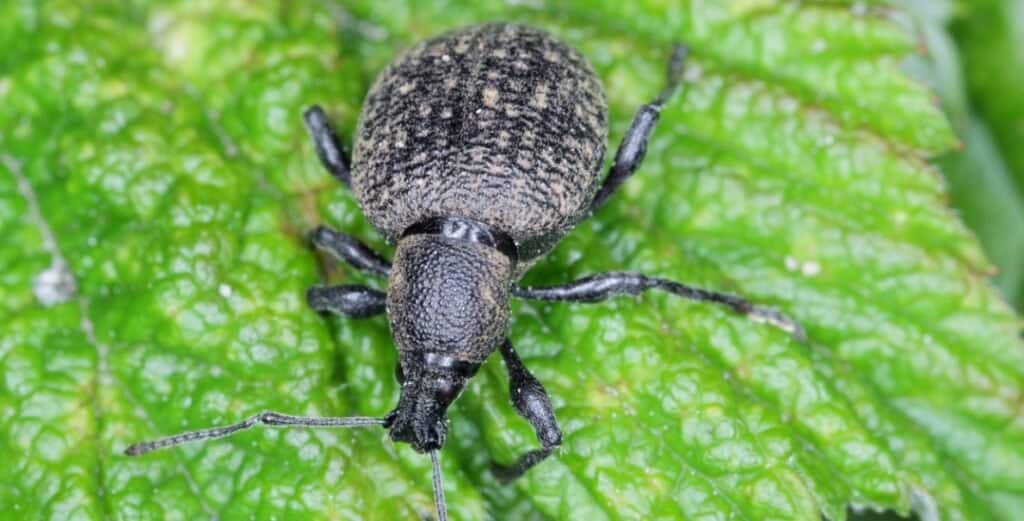
The black vine weevil feeds on cultivated and wild plants, causing extensive damage to gardens.
©iStock.com/Tomasz Klejdysz
Description: Adult vine weevils are matte black, oval-shaped, and around half an inch long. They have short, broad snouts and notched antennae. They also have fused wing covers and cannot fly.
Location/Habitat: In North America, they range from Southern Canada to the northern half of the United States, from the Carolinas and west to Oregon. They thrive in gardens, especially where broadleaved evergreen plants grow.
Diet: They feed on over 100 cultivated and wild plants.
Problems: These pests invade gardens and cause extensive damage to plants.
4. Black Carpenter Ant
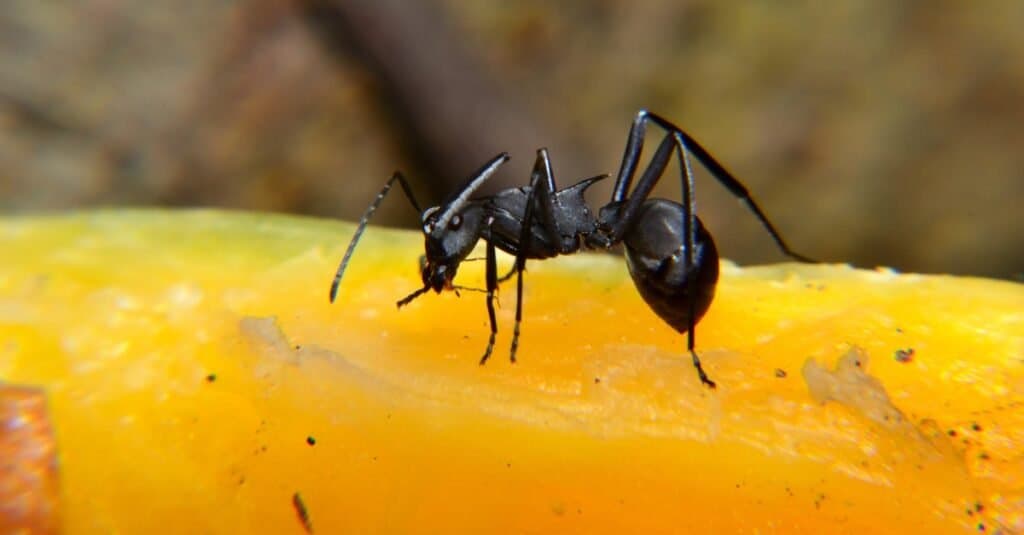
The black
carpenter ant
is abundant in areas east of the Rocky Mountains, where they inhabit residential areas and woodlands.
©Kras_Stock/Shutterstock.com
Description: Black carpenter ants reach over half an inch long and are distinguishable from other ants by their dull black color and yellowish-white hairs on their abdomens. They have elbowed antennae and are among the largest ants in North America.
Location/Habitat: Their range is abundant east of the Rocky Mountains, where they inhabit woodlands, forest edges, and residential areas.
Diet: Like most ants, carpenter ants feed on sugar and protein. They live on dead insects and fruit when outside. But will also chew their way through wet and moldy wood.
Problems: Carpenter ants invade homes and can be detrimental to the structure of your home as they excavate wooded areas.
5. Black-Legged Tick
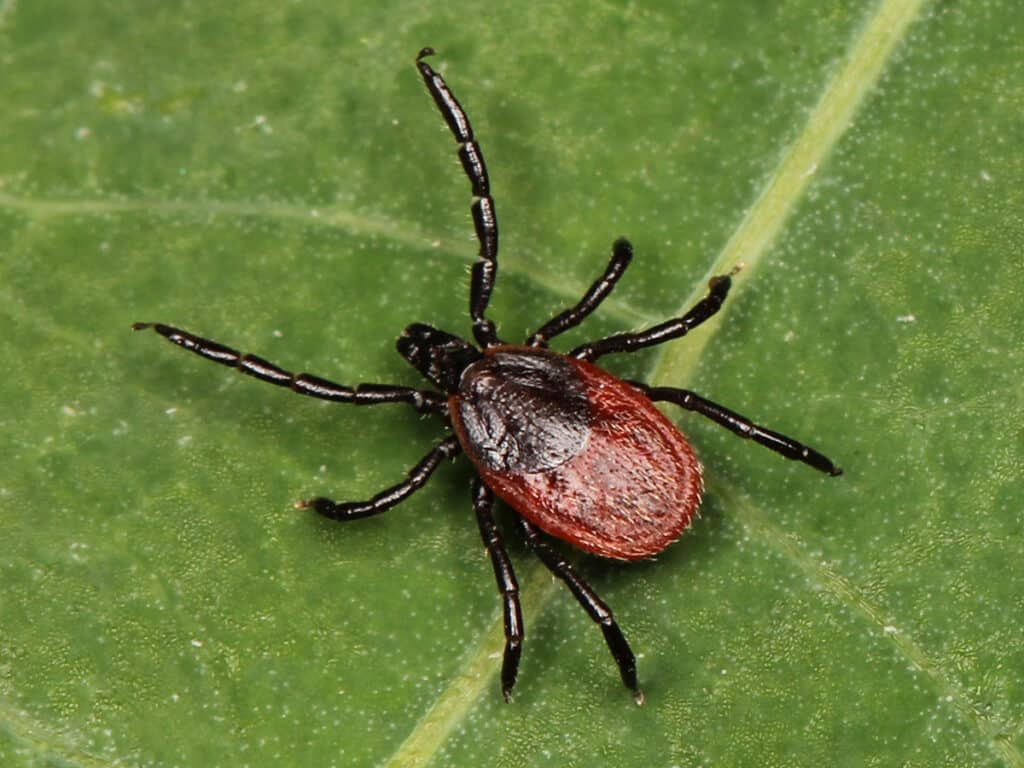
Black-legged ticks are common in the Northeastern United States. They drink blood from humans and animals and can cause serious diseases.
©Kaldari / Creative Commons – License
Description: The black-legged tick, also known as the deer tick, has a flat, oval body with orangish-brown coloring and black legs. They may look darker after feeding on a host when their abdomens are engorged.
Location/Habitat: This species is common in the Northeastern United States in the New England region. They inhabit wooded areas and fields, often found around buildings in remote areas.
Diet: Ticks drink blood from many hosts, such as mammals, birds, amphibians, and reptiles.
Problems: Deer ticks, along with other ticks, can cause serious diseases, such as Lyme disease and Babesiosis.
6. Black Garden Ant
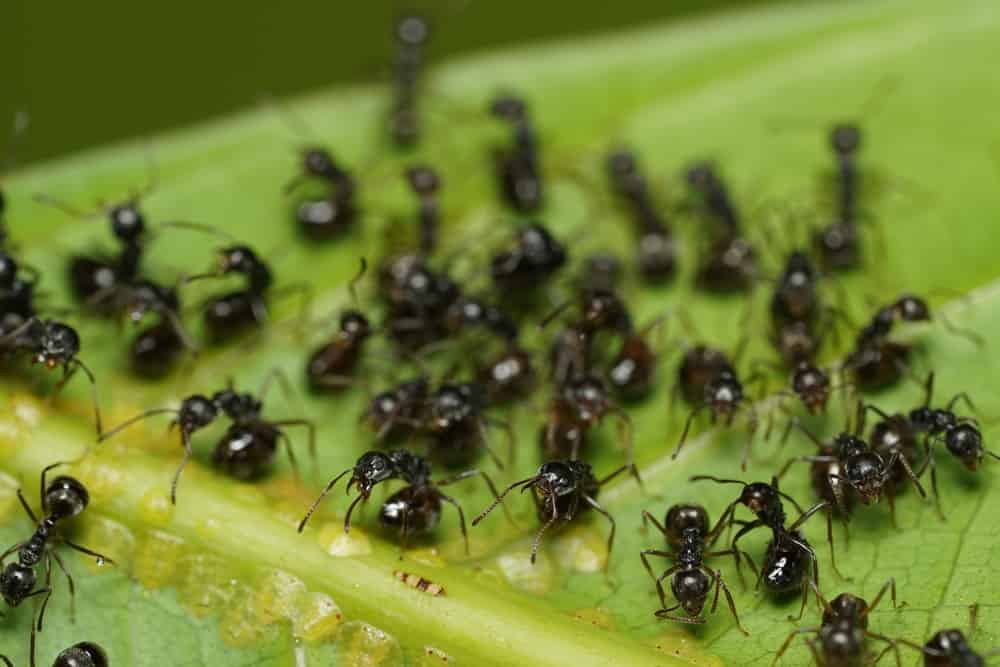
The black garden ant is abundant across the world and lives in many habitats. They occasionally find their way indoors.
©Sufian Hanif/Shutterstock.com
Description: These common black ants are glossy black, long, and slim. But they can differ in appearance based on their caste. Queens have brown stripes on their abdomens and can reach 0.35 inches long. Workers are much smaller but can increase in size over generations.
Location/Habitat: This species is abundant across the world and lives in many environments, from forests to open areas. But they are especially fond of gardens, often making their way inside homes.
Diet: Black garden ants consume ripe fruit, other insects, and honeydew produced by aphids. But they will eat almost any kind of sweet food.
Problems: This species can invade homes and be a general nuisance. But they can also cause structural damage to buildings by moving the soil underneath the foundation.
7. Millipede
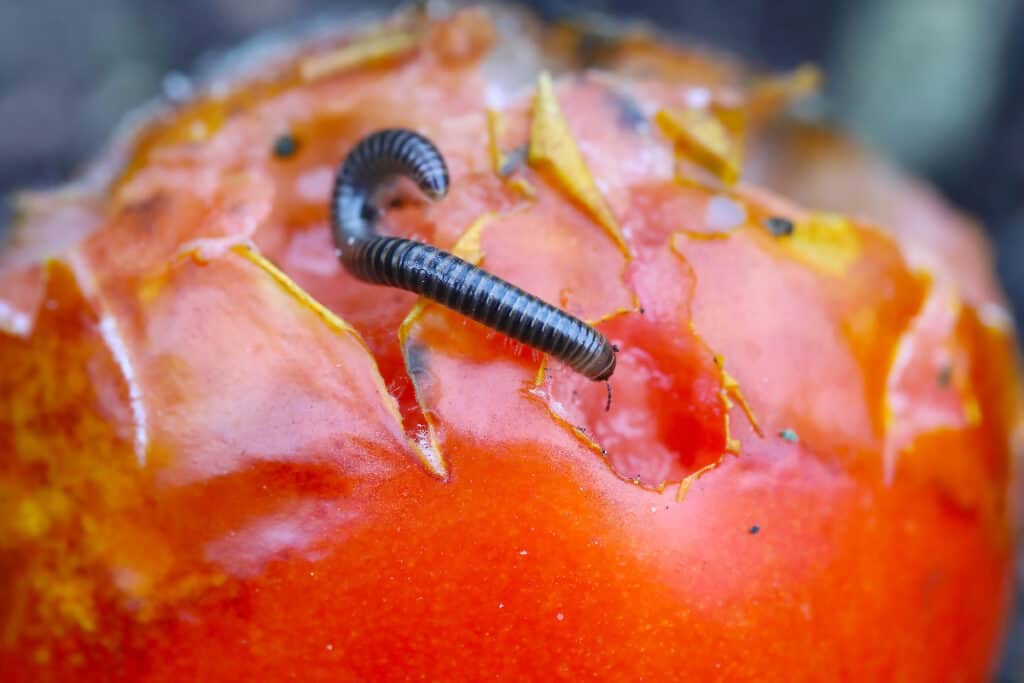
The
millipede
lives on every continent except Antarctica.
©Tomasz Klejdysz/Shutterstock.com
Description: Millipedes are elongated and cylindrical, featuring at least 20 segments. Each segment has two pairs of jointed legs. These bugs can come in many colors, including black. And they vary in length, growing between 1/16th of an inch up to 14 inches.
Location/Habitat: The millipede lives on every continent except Antarctica. They inhabit many environments but thrive on the forest floor under leaves, dead wood, and soil, especially in moist areas.
Diet: They are detrivores that feed on decomposing vegetation, feces, and soil. These bugs play an important role in decomposition.
Problems: Millipedes are typically seen as helpful bugs. But they can also damage seedlings when they feed on stems and leaves. They can also invade homes in large numbers when migrating.
8. Ground Beetle
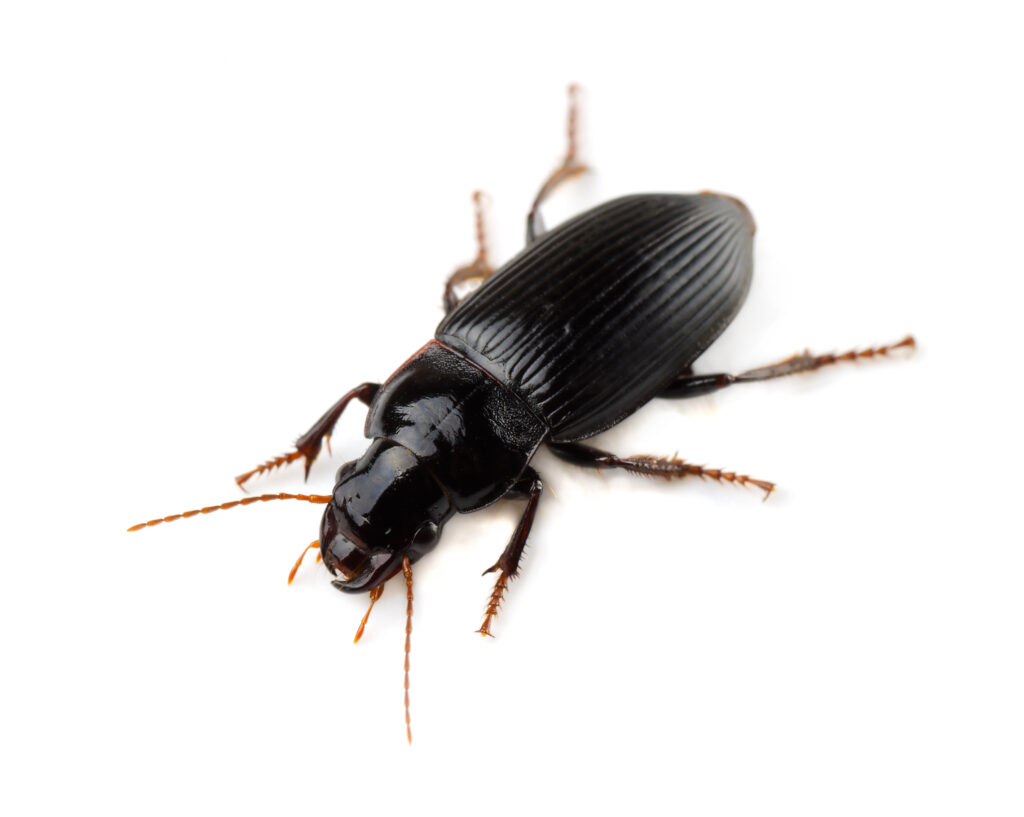
Ground beetles are helpful bugs and are not known to cause any problems to humans or the environment.
©iStock.com/Coprid
Description: The ground beetle is large within its family and features varying shapes and colors. However, the most common color of ground beetle is shiny black or metallic. They also have ridged wing covers and a groove on their forelegs with a hair comb.
Location/Habitat: They have a cosmopolitan range, meaning they live around most of the world. These types of black bugs also have a wide-ranging habitat, from mountains to deserts and seashores. But forests are their most common environment.
Diet: Most ground beetles eat soil-dwelling insects such as caterpillars, worms, maggots, slugs, and ants.
Problems: Ground beetles are not known to cause any problems to humans or the environment. They may occasionally find their way indoors and pinch if they are mishandled. But they are not dangerous, only a mild nuisance.
9. Fungus Gnat
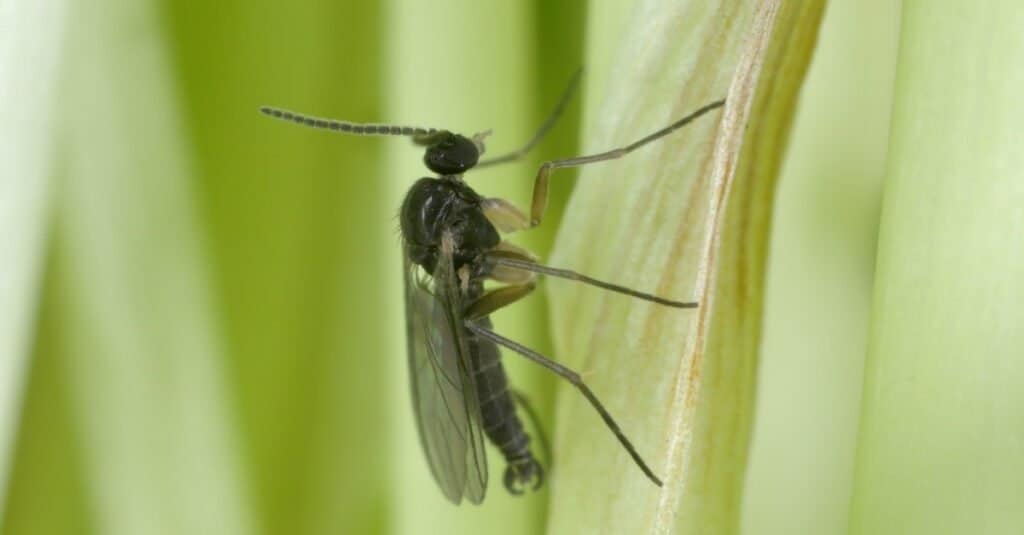
The fungus gnat is a tiny black bug that can become a pest inside or outside the home.
©iStock.com/Tomasz Klejdysz
Description: Fungus gnats are small and black or dark brown. Adults reach 0.08 to 0.3 inches long and are considered short-lived gnats. They do not fly well, preferring to walk swiftly across plants and soil.
Location/Habitat: These bugs live everywhere except Antarctica and inhabit moist areas near fungi or plants.
Diet: The fungus gnat consumes fungi, compost, mold, mulch, grass clippings, and hair.
Problems: These types of black bugs can damage roots and stunt plant growth. But they are especially a nuisance to humans. They can fly into eyes and noses when outdoors or inside. And they can become pests inside homes, often found in high-moisture areas like crawl spaces, kitchens, and bathrooms.
Why Do Most Bugs Seem to Be Black or Brown?
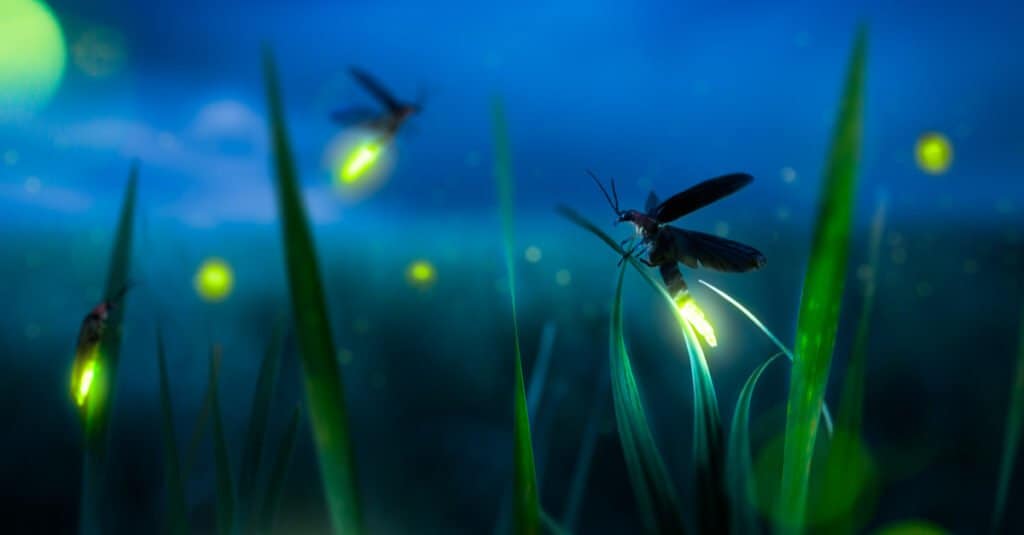
While fireflies appear to have uninteresting black-colored bodies, they also possess bioluminescence which enables them to light up.
©Fer Gregory/Shutterstock.com
The colors of many insects are directly affected by their reflection or absorption of sunlight. One exception would be a few insects that have bioluminescence–certain flies, springtails, and beetles among them. The majority of insects possess a pigment called melanin. Melanins usually produce shades like reddish hues of brown or black. Other substances like pterins and carotenoids can create yellows, reds, oranges, greens, blues, violets, and golden colors.
Most bugs have either melanin or pterin pigments. In the case of bugs that appear black or brown, they primarily possess melanin.
Summary of 9 Types of Black Bugs
| # | Black Bug | Habitat |
|---|---|---|
| 1 | Black Carpet Beetle | Primarily live outside on plants like crape myrtles or around doors and windows |
| 2 | Asiatic Cockroach | Drawn to trash and decaying matter – will try to infest homes |
| 3 | Black Vine Weevil | Thrive in gardens |
| 4 | Black Carpenter Ant | Woodlands, forest edges and residential areas |
| 5 | Black-Legged Tick | Woodlands, forest edges, and residential areas |
| 6 | Black Garden Ant | Gardens – will try to infest homes |
| 7 | Millipede | Forest floor under leaves, dead wood, and moist soil |
| 8 | Ground Beetle | Wide-ranging but prefer forests |
| 9 | Fungus Gnat | Moist areas near fungi or plants. |
The photo featured at the top of this post is © Akil Rolle-Rowan/Shutterstock.com
Thank you for reading! Have some feedback for us? Contact the AZ Animals editorial team.






